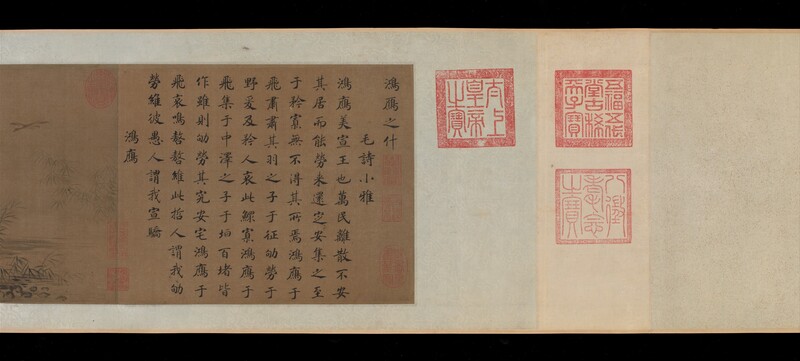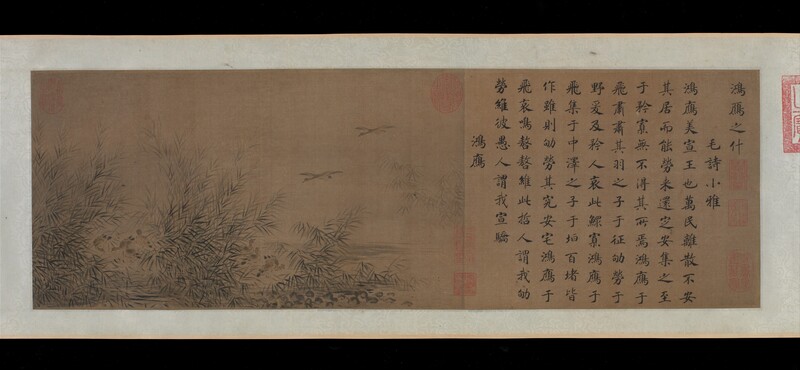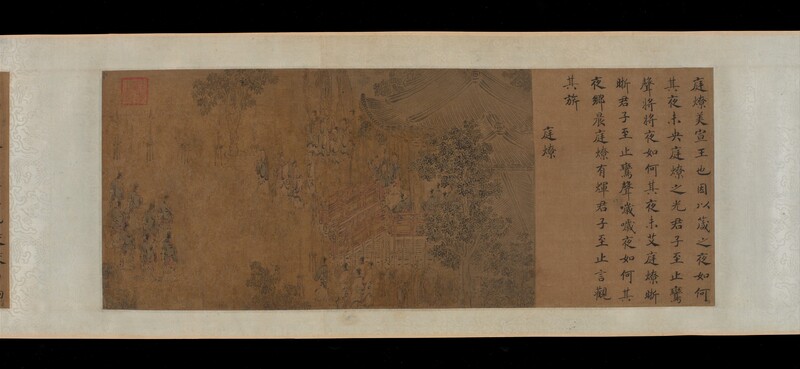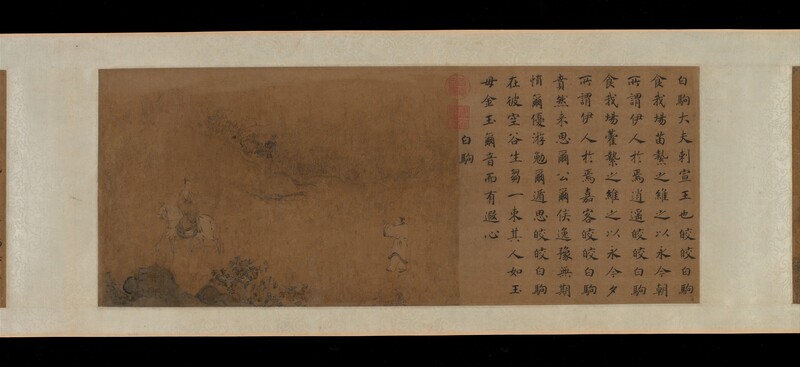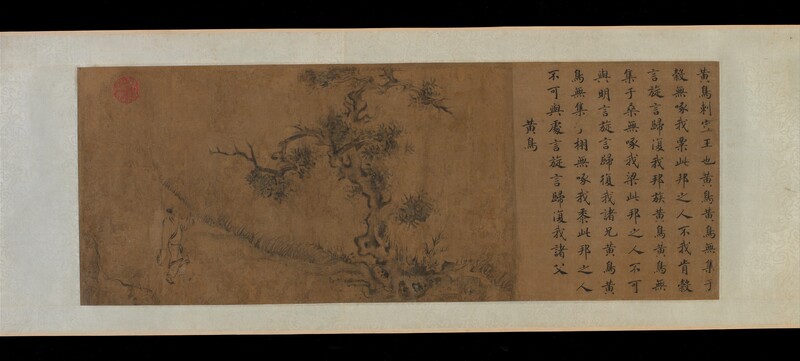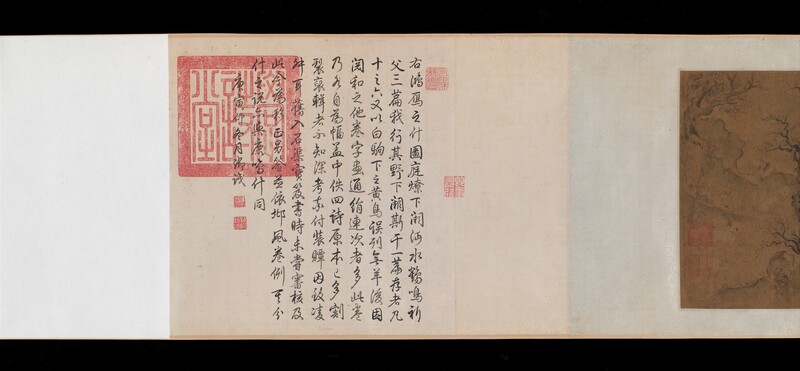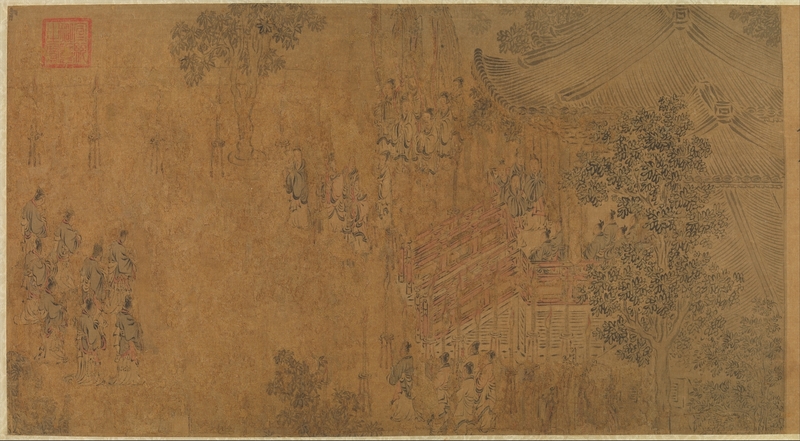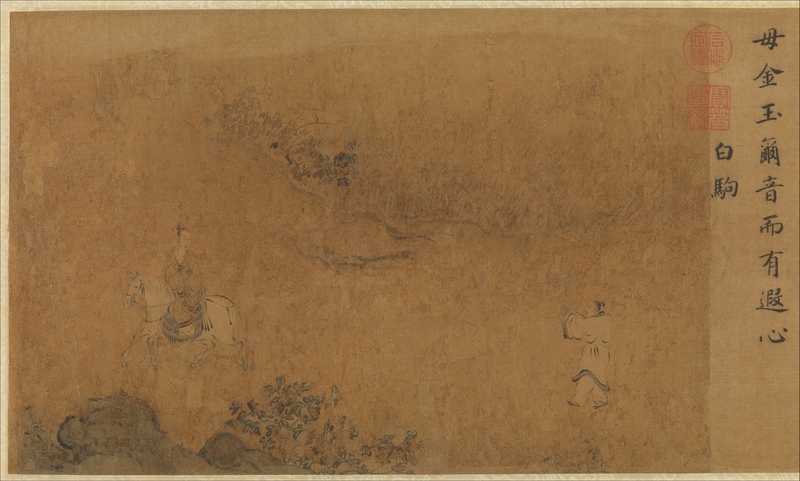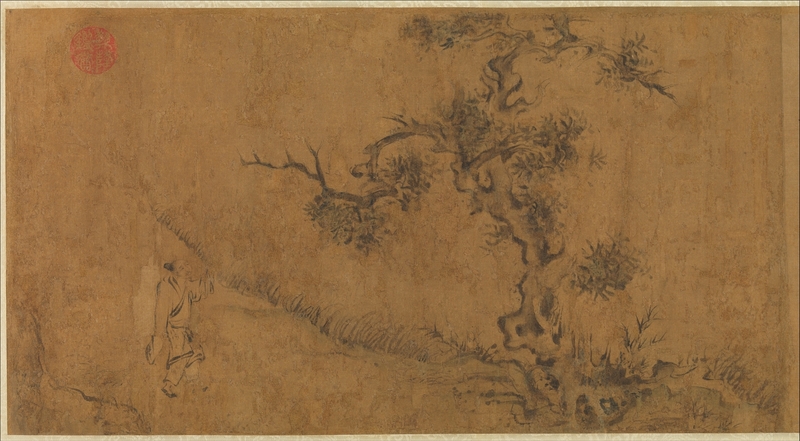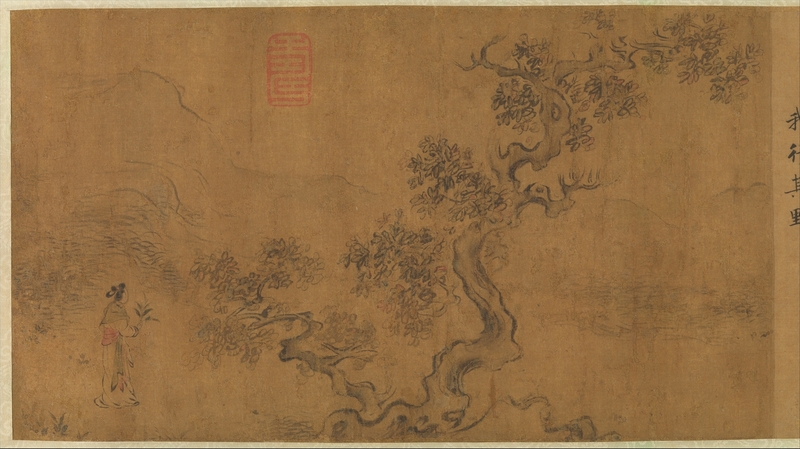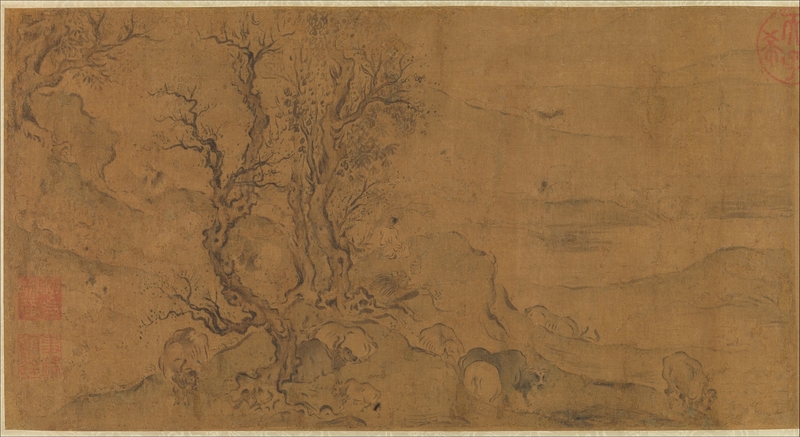Courtly Odes, Beginning with "Wild Geese" 詩經小雅鴻雁之什六篇圖
Item
Title
Courtly Odes, Beginning with "Wild Geese"
詩經小雅鴻雁之什六篇圖
詩經小雅鴻雁之什六篇圖
Description
(none)
identifier
40052
Source
https://www.metmuseum.org/art/collection/search/40052
Creator
Ma Hezhi
馬和之
馬和之
annotates
Other inscriptions on painting[1]
Unidentified artist in the style of the Song emperor Gaozong (r. 1127–1162), 57 columns in standard script, undated:
1. Wild Geese (12 columns in standard script)
The wild geese are flying;
Suk, suk go their wings.
The soldiers are on the march;
Painfully they struggle through the wilds.
In dire extremity are the strong men;
Sad are their wives, left all alone.
The wild geese are flying;
They have lighted in the middle of the marsh.
The soldiers are walling a fort;
The hundred cubits have all risen.
Though they struggle so painfully,
At last they are safely housed.
The wild geese are flying;
Dolefully they cry their discontent.
But these were wise men
Who urged us in our toil,
And those were foolish men
Who urged us to make mischief and rebel.
Wild Geese
鴻鴈之什
毛詩小雅
鴻鴈,美宣王也。萬民離散,不安其居。而能勞來還,定安集之。至于矜寡,無不得其所焉。
鴻鴈于飛,肅肅其羽。之子于征,劬勞于野。爰及矜人,哀此鰥寡。
鴻鴈于飛,集于中澤。之子于垣,百堵皆作。雖則劬勞,其究安宅。
鴻鴈于飛,哀鳴嗷嗷。維此哲人,謂我劬勞。維彼愚人,謂我宣驕 。
鴻鴈
2. Courtyard Torches (7 columns in standard script)
What of the night?
The night is not yet spent.
The torches in the courtyeard are alight.
But my lord has come;
Tinkle, tinkle go his harness-bells.
What of the night?
The night is not yet old.
The torches in the courtyard are bright.
But my lord has come;
Twit, twit go the bells.
What of the night?
The night nears dawn.
The torches in the courtyard gleam.
My lord has come;
I can see his banners.
Courtyard Torches
庭燎,美宣王也,因以箴之。
夜如何其?夜未央。庭燎之光,君子至止,鸞聲將將。
夜如何其?夜未艾。庭燎晰晰,君子至止,鸞聲噦噦。
夜如何其?夜鄉晨。庭燎有煇,君子至止,言觀其旂。
庭燎
3. White Colt (10 columns in standard script)
Unsullied the white colt
Eating the young shoots of my stackyard.
Keep it tethered, keep it tied
All day long.
The man whom I love
Here makes holiday.
Unsullied the white colt
Eating the bean leaves of my stackyard.
Keep it tethered, keep it tied
All night long.
The man whom I love
Is here, a lucky guest.
Unsullied the white colt
That came so swiftly.
Like a duke, like a lord
Let your revels have no end.
Prolong your idle play,
Protract your leisure.
Unsullied the white colt
In that deserted valley,
With a bundle of fresh fodder.
'Though you, its master, are fair as jade
Do not let the news off you be rare as gold or jade,
Keeping your thoughts far away.’
White Colt
白駒,大夫刺宣王也。
皎皎白駒,食我場苗。縶之維之,以永今朝。所謂伊人,於焉逍遙。
皎皎白駒,食我場藿。縶之維之,以永今夕。所謂伊人,於焉嘉客。
皎皎白駒,賁然來思。爾公爾侯,逸豫無期。慎爾優游,勉爾遁思。
皎皎白駒,在彼空谷,生芻一束。其人如玉,毋金玉爾音,而有遐心。
白駒
4. Yellow Bird (8 columns in standard script)
O oriole, yellow bird,
Do not settle on the corn,
Do not peck at my millet.
The people of this land
Are not minded to nurture me.
I must go back, go home
To my own land and kin.
O oriole, yellow bird,
Do not settle on the mulberries,
Do not peck my sorghum.
With the people of this land
One can make no covenant.
I must go back, go home
To where my brothers are.
O oriole, yellow bird
Do not settle on the oaks,
Do not peck my wine–millet.
With the people of this land
One can come to no understanding.
I must go back, go home
To where my own men are.
Yellow Bird
黃鳥,刺宣王也。
黃鳥黃鳥,無集于榖,無啄我粟。此邦之人,不我肯榖。言旋言歸,復我邦族。
黃鳥黃鳥,無集于桑,無啄我梁。此邦之人,不可與明。言旋言歸,復我諸兄。
黃鳥黃鳥,無集于栩,無啄我黍。此邦之人,不可與處。言旋言歸,復我諸父 。
黃鳥
5. I Walk the Wilderness (8 columns in standard script)
I went into the country;
Deep the shade of the ailanto.
It was as bride and wife
That I came to your house.
But you did not provide for me––
Sent me back to land and home.
I went into the country;
I plucked the dockleaf.
It was as bride and wife
That I came to live with you.
But you did not provide for me––
Back to my home you sent me.
I went into the country;
I plucked the pokerweed.
You thought nothing of the old marriage––
Found for yourself a new mate.
Not for her wealth, oh no!
But merely for a change.
I Walk the Wilderness
我行其野,刺宣王也。
我行其野,蔽芾其樗。昏姻之故,言就爾居。爾不我畜,復我邦家 。
我行其野,言采其蓫。昏姻之故,言就爾宿。爾不我畜,言歸思復。
我行其野,言采其葍。不思舊姻,求爾新特。成不以富,亦祇以異。
我行其野
6. No Goats (12 columns in standard script)
Who says you have no sheep?
Three hundred is the flock.
Who says you have no cattle?
Ninety are the black–lips.
Here your rams come,
Their horns thronging;
Here your cattle come,
Their ears flapping.
Some go down the slope,
Some are drinking in the pool,
Some are sleeping, some waking.
Here your herdsmen come
In rush–cloak and bamboo–hat,
Some shouldering their dinners.
Only thirty brindled beasts!
Your sacrifices will not go short.
Your herdsman comes,
Bringing faggots, bringing brushwood,
With the cock–game, with hen–game.
Your rams come,
Sturdy and sound;
None that limps, none that ails.
He beckons to them with raised arm;
All go up into the stall.
Your herdsman dreams,
Dreams of locusts and fish,
Of banners and flags.
A wise man explains the dreams:
'Locusts and fishes
Mean fat years.
Flags and banners
Mean a teeming house and home.'
無羊,宣王考牧也。
誰謂爾無羊?三百維群。誰謂爾無牛?九十其犉。爾羊來思,其角濈濈。爾牛來思,其耳濕濕。
或降于阿,或飲于池,或寢或訛。爾牧來思,何蓑何笠。或負其餱,三十維物,爾牲則具。
爾牧來思,以薪以蒸,以雌以雄。爾羊來思,矜矜兢兢,不騫不崩。麾之以肱,畢來既升。
牧人乃夢,眾維魚矣,旐維旟矣。大人占之:眾維魚矣,實維豐年。旐維旟矣,室家溱溱。
無羊
Label strip
Qing emperor Qianlong 清帝乾隆 (r. 1736–1795), 1 column in semi-cursive script, undated; 1 seal:
Transcriptions by the Song emperor Gaozonog and illustrations by Ma Hezhi of six poems from the set of ten in the 'Wild Geese' sequence of the Xiaoya [section of the Book of Songs].
宋高宗書、馬和之畫 《小雅鴻鴈之什六篇圖 》。 [印]: 乾隆宸翰
Colophon
Qing emperor Qianlong 清帝乾隆 (r. 1736–1795), 10 columns in semi-cursive script, dated 1770; 5 seals:
右 《鴻鴈之什圖》,〈庭燎〉下闕 〈沔水〉、〈鶴鳴〉、〈祈父〉三篇,〈我行其野〉下闕 〈斯干 〉一篇,存者凡十之六,又以 〈白駒〉 下之〈黃鳥〉 誤列〈無羊〉後。因閱和之他卷,字畫通絹連次者多,此卷乃各自為幅。蓋中佚四詩,原本已多割裂,裒輯者不知深考,率付裝贉,因致凌舛耳。舊入 《石渠寶笈》 書時, 未嘗審核及此,今為移正另簽,並依 《邶風》 卷例,其分什之說,亦與〈鹿鳴〉什同。 庚寅仲冬月御識。 [印]: 乾隆宸翰、幾暇臨池、石渠繼鋻、即事多所欣、學詩堂
[1] Translations of poems from Arthur Waley, The Book of Songs, New York, Grove Press, 1960.
Unidentified artist in the style of the Song emperor Gaozong (r. 1127–1162), 57 columns in standard script, undated:
1. Wild Geese (12 columns in standard script)
The wild geese are flying;
Suk, suk go their wings.
The soldiers are on the march;
Painfully they struggle through the wilds.
In dire extremity are the strong men;
Sad are their wives, left all alone.
The wild geese are flying;
They have lighted in the middle of the marsh.
The soldiers are walling a fort;
The hundred cubits have all risen.
Though they struggle so painfully,
At last they are safely housed.
The wild geese are flying;
Dolefully they cry their discontent.
But these were wise men
Who urged us in our toil,
And those were foolish men
Who urged us to make mischief and rebel.
Wild Geese
鴻鴈之什
毛詩小雅
鴻鴈,美宣王也。萬民離散,不安其居。而能勞來還,定安集之。至于矜寡,無不得其所焉。
鴻鴈于飛,肅肅其羽。之子于征,劬勞于野。爰及矜人,哀此鰥寡。
鴻鴈于飛,集于中澤。之子于垣,百堵皆作。雖則劬勞,其究安宅。
鴻鴈于飛,哀鳴嗷嗷。維此哲人,謂我劬勞。維彼愚人,謂我宣驕 。
鴻鴈
2. Courtyard Torches (7 columns in standard script)
What of the night?
The night is not yet spent.
The torches in the courtyeard are alight.
But my lord has come;
Tinkle, tinkle go his harness-bells.
What of the night?
The night is not yet old.
The torches in the courtyard are bright.
But my lord has come;
Twit, twit go the bells.
What of the night?
The night nears dawn.
The torches in the courtyard gleam.
My lord has come;
I can see his banners.
Courtyard Torches
庭燎,美宣王也,因以箴之。
夜如何其?夜未央。庭燎之光,君子至止,鸞聲將將。
夜如何其?夜未艾。庭燎晰晰,君子至止,鸞聲噦噦。
夜如何其?夜鄉晨。庭燎有煇,君子至止,言觀其旂。
庭燎
3. White Colt (10 columns in standard script)
Unsullied the white colt
Eating the young shoots of my stackyard.
Keep it tethered, keep it tied
All day long.
The man whom I love
Here makes holiday.
Unsullied the white colt
Eating the bean leaves of my stackyard.
Keep it tethered, keep it tied
All night long.
The man whom I love
Is here, a lucky guest.
Unsullied the white colt
That came so swiftly.
Like a duke, like a lord
Let your revels have no end.
Prolong your idle play,
Protract your leisure.
Unsullied the white colt
In that deserted valley,
With a bundle of fresh fodder.
'Though you, its master, are fair as jade
Do not let the news off you be rare as gold or jade,
Keeping your thoughts far away.’
White Colt
白駒,大夫刺宣王也。
皎皎白駒,食我場苗。縶之維之,以永今朝。所謂伊人,於焉逍遙。
皎皎白駒,食我場藿。縶之維之,以永今夕。所謂伊人,於焉嘉客。
皎皎白駒,賁然來思。爾公爾侯,逸豫無期。慎爾優游,勉爾遁思。
皎皎白駒,在彼空谷,生芻一束。其人如玉,毋金玉爾音,而有遐心。
白駒
4. Yellow Bird (8 columns in standard script)
O oriole, yellow bird,
Do not settle on the corn,
Do not peck at my millet.
The people of this land
Are not minded to nurture me.
I must go back, go home
To my own land and kin.
O oriole, yellow bird,
Do not settle on the mulberries,
Do not peck my sorghum.
With the people of this land
One can make no covenant.
I must go back, go home
To where my brothers are.
O oriole, yellow bird
Do not settle on the oaks,
Do not peck my wine–millet.
With the people of this land
One can come to no understanding.
I must go back, go home
To where my own men are.
Yellow Bird
黃鳥,刺宣王也。
黃鳥黃鳥,無集于榖,無啄我粟。此邦之人,不我肯榖。言旋言歸,復我邦族。
黃鳥黃鳥,無集于桑,無啄我梁。此邦之人,不可與明。言旋言歸,復我諸兄。
黃鳥黃鳥,無集于栩,無啄我黍。此邦之人,不可與處。言旋言歸,復我諸父 。
黃鳥
5. I Walk the Wilderness (8 columns in standard script)
I went into the country;
Deep the shade of the ailanto.
It was as bride and wife
That I came to your house.
But you did not provide for me––
Sent me back to land and home.
I went into the country;
I plucked the dockleaf.
It was as bride and wife
That I came to live with you.
But you did not provide for me––
Back to my home you sent me.
I went into the country;
I plucked the pokerweed.
You thought nothing of the old marriage––
Found for yourself a new mate.
Not for her wealth, oh no!
But merely for a change.
I Walk the Wilderness
我行其野,刺宣王也。
我行其野,蔽芾其樗。昏姻之故,言就爾居。爾不我畜,復我邦家 。
我行其野,言采其蓫。昏姻之故,言就爾宿。爾不我畜,言歸思復。
我行其野,言采其葍。不思舊姻,求爾新特。成不以富,亦祇以異。
我行其野
6. No Goats (12 columns in standard script)
Who says you have no sheep?
Three hundred is the flock.
Who says you have no cattle?
Ninety are the black–lips.
Here your rams come,
Their horns thronging;
Here your cattle come,
Their ears flapping.
Some go down the slope,
Some are drinking in the pool,
Some are sleeping, some waking.
Here your herdsmen come
In rush–cloak and bamboo–hat,
Some shouldering their dinners.
Only thirty brindled beasts!
Your sacrifices will not go short.
Your herdsman comes,
Bringing faggots, bringing brushwood,
With the cock–game, with hen–game.
Your rams come,
Sturdy and sound;
None that limps, none that ails.
He beckons to them with raised arm;
All go up into the stall.
Your herdsman dreams,
Dreams of locusts and fish,
Of banners and flags.
A wise man explains the dreams:
'Locusts and fishes
Mean fat years.
Flags and banners
Mean a teeming house and home.'
無羊,宣王考牧也。
誰謂爾無羊?三百維群。誰謂爾無牛?九十其犉。爾羊來思,其角濈濈。爾牛來思,其耳濕濕。
或降于阿,或飲于池,或寢或訛。爾牧來思,何蓑何笠。或負其餱,三十維物,爾牲則具。
爾牧來思,以薪以蒸,以雌以雄。爾羊來思,矜矜兢兢,不騫不崩。麾之以肱,畢來既升。
牧人乃夢,眾維魚矣,旐維旟矣。大人占之:眾維魚矣,實維豐年。旐維旟矣,室家溱溱。
無羊
Label strip
Qing emperor Qianlong 清帝乾隆 (r. 1736–1795), 1 column in semi-cursive script, undated; 1 seal:
Transcriptions by the Song emperor Gaozonog and illustrations by Ma Hezhi of six poems from the set of ten in the 'Wild Geese' sequence of the Xiaoya [section of the Book of Songs].
宋高宗書、馬和之畫 《小雅鴻鴈之什六篇圖 》。 [印]: 乾隆宸翰
Colophon
Qing emperor Qianlong 清帝乾隆 (r. 1736–1795), 10 columns in semi-cursive script, dated 1770; 5 seals:
右 《鴻鴈之什圖》,〈庭燎〉下闕 〈沔水〉、〈鶴鳴〉、〈祈父〉三篇,〈我行其野〉下闕 〈斯干 〉一篇,存者凡十之六,又以 〈白駒〉 下之〈黃鳥〉 誤列〈無羊〉後。因閱和之他卷,字畫通絹連次者多,此卷乃各自為幅。蓋中佚四詩,原本已多割裂,裒輯者不知深考,率付裝贉,因致凌舛耳。舊入 《石渠寶笈》 書時, 未嘗審核及此,今為移正另簽,並依 《邶風》 卷例,其分什之說,亦與〈鹿鳴〉什同。 庚寅仲冬月御識。 [印]: 乾隆宸翰、幾暇臨池、石渠繼鋻、即事多所欣、學詩堂
[1] Translations of poems from Arthur Waley, The Book of Songs, New York, Grove Press, 1960.
Abstract
Collectors' seals
Qing emperor Qianlong 清帝乾隆 (r. 1736–1795)
乾隆鋻賞
乾隆御覽之寳
三希堂
三希堂精鋻璽
石渠寳笈
御書房鋻藏寳
宜子孫
石渠定鋻
寳笈重編
壽
學書堂
心氣和平
事理通達
古希天子
五福五代堂古稀天子寳
八徵耄念之寶
太上皇帝之寳
心氣和平
事理通達
嘉慶御覽之寳
宣統御覽之寳
Unidentified: 2
Qing emperor Qianlong 清帝乾隆 (r. 1736–1795)
乾隆鋻賞
乾隆御覽之寳
三希堂
三希堂精鋻璽
石渠寳笈
御書房鋻藏寳
宜子孫
石渠定鋻
寳笈重編
壽
學書堂
心氣和平
事理通達
古希天子
五福五代堂古稀天子寳
八徵耄念之寶
太上皇帝之寳
心氣和平
事理通達
嘉慶御覽之寳
宣統御覽之寳
Unidentified: 2
Rights Holder
Metropolitan Museum of Art
Identifier
1984.475.1
References
Wang Jie 王杰 et al. Midian zhulin shiqu baoji xubian 秘殿珠林石渠寶笈續編 (Catalogue of painting and calligraphy in the Qianlong imperial collection, second series). Preface dated 1793. Facsimile reprint of an original manuscript copy. 8 vols. vol. 4, Taipei: National Palace Museum, 1971, pp. 2040–41.
Fong, Wen C. Beyond Representation: Chinese Painting and Calligraphy, 8th–14th Century. New York: The Metropolitan Museum of Art, 1992, p. 222, pl. 29.
Fong, Wen C. Beyond Representation: Chinese Painting and Calligraphy, 8th–14th Century. New York: The Metropolitan Museum of Art, 1992, p. 222, pl. 29.

